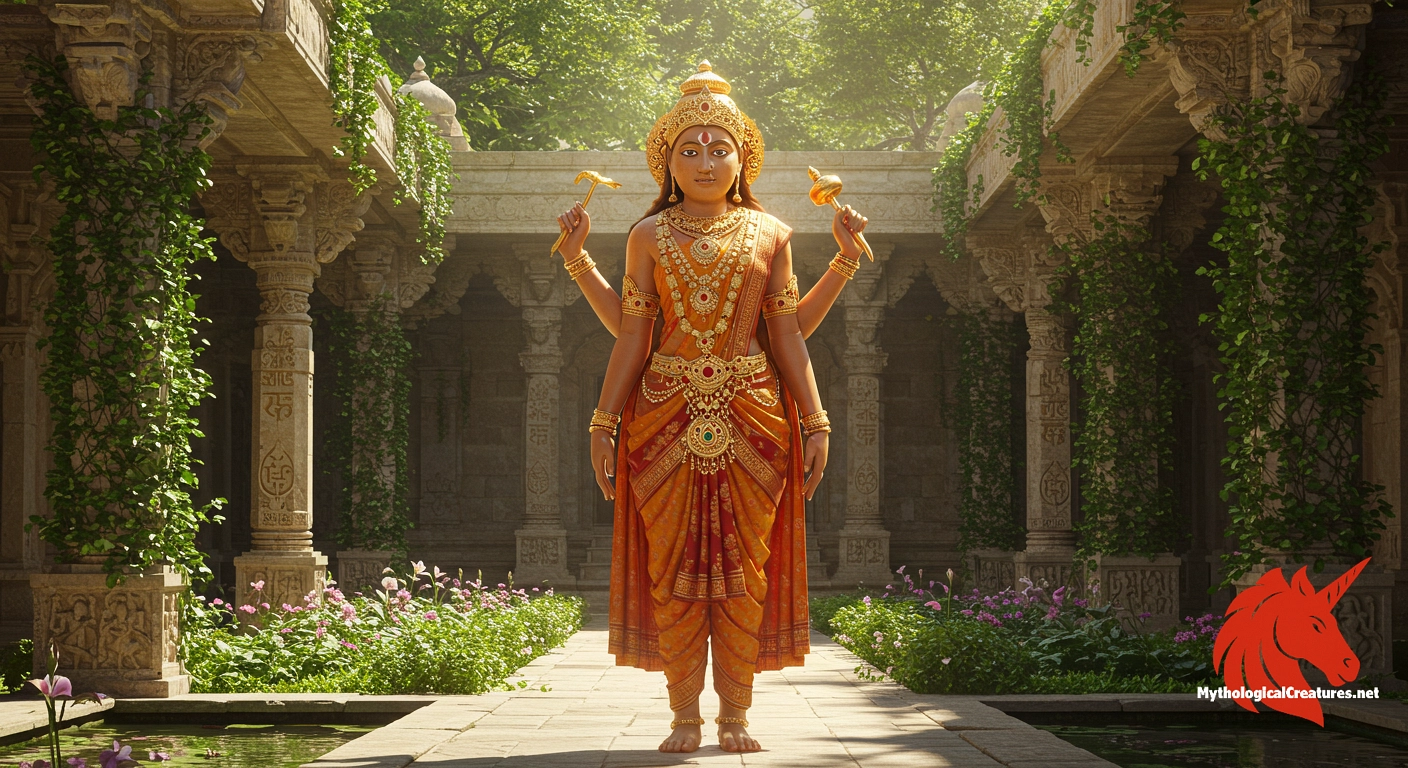Chakreshvari: Chakreshvari, also known as Apraticakra, is the guardian goddess and yakshini of Rishabhanatha in Jain cosmology.

Chakreshvari
Chakreshvari - Chakreshvari is venerated for her role in protecting Rishabhanatha and her tutelary influence over the Sarawagi Jain community, symbolizing divine guardianship.
Origins & First Encounters
Chakreshvari occupies a central position in Jain cosmology as the guardian goddess and yakshini attendant to Rishabhanatha, the first Tirthankara.
Her origins are steeped in ancient spiritual traditions that seek to encapsulate divine protection and ethical guidance.
She first appears in early temple inscriptions and iconographic art, where her benevolent yet powerful nature is immortalised for devotees.
The goddess is revered not only for her celestial guardianship but also as an emblem of the disciplined moral order that Jain philosophy upholds.
Her depiction in early texts and local legends emphasises her role in supporting the religious journey toward liberation.
As a tutelary deity of the Sarawagi Jain community, she reinforces social cohesion and cultural identity through ritual worship.
The narratives surrounding Chakreshvari have been passed down over centuries, adapting to the evolving cultural and religious landscapes.
Her enduring presence in devotional practices reflects the intrinsic link between spiritual protection and everyday life among Jain adherents.
The goddess’s mythic stature continues to inspire both scholarly study and popular veneration, marking her as a pivotal figure in Jain tradition.
Source Texts & Tale Variants
Ancient Jain texts and temple inscriptions form the primary corpus through which Chakreshvari’s story has been preserved.
These sources reveal her integral role as an attendant deity to Rishabhanatha, intricately woven into the fabric of Jain cosmology.
Excavated reliefs and mural paintings provide visual testimony to her evolving iconography over the centuries.
Literary references in scriptural compendiums, though often brief, highlight her protective attributes intertwined with spiritual symbolism.
Oral traditions within the Sarawagi community further embellish her myth, adding layers of regional colour and ritual significance.
Different recensions and local folklore variations offer subtle differences that underscore a wide spectrum of devotional practices.
Some accounts detail her interventions during cosmic disturbances while others emphasise her role in safeguarding sacred spaces.
These diverse accounts, ranging from scriptural to folk renditions, demonstrate a multifaceted portrayal that adapts to the needs of the community.
The convergence of literary and artistic traditions in her narrative illustrates a rich tapestry of cultural and religious influences.
Form & Powers
Chakreshvari is traditionally depicted as a radiant deity adorned in sumptuous regalia that reflects her divine status.
Her visage is serene yet commanding, with expressive eyes that seem to encapsulate the wisdom and benevolence of the divine.
Iconography frequently includes the prominent wheel or chakra, a motif that symbolises her association with cosmic order and the cyclical nature of time.
Her body is often portrayed with an idealised form, marked by graceful contours and elaborate jewellery that signifies her regal presence.
Some artistic representations show her with multiple arms, each holding symbolic items that represent various aspects of protection and prosperity.
The delicate interplay of rich fabrics and intricate ornamentation in her attire speaks to the detailed craftsmanship of Jain art.
Artists render her figure with a balance of softness and authority, embodying both nurturing compassion and unyielding vigilance.
Her representation varies in scale from life-size temple sculptures to smaller devotional icons, each capturing her essential character.
Despite regional variations, the consistency in her physical depiction underscores a timeless iconographic tradition.
Regional Faces
Across different regions in India, the portrayal of Chakreshvari reflects a fascinating confluence of local artistic tradition and established religious iconography.
In parts of Gujarat and Rajasthan, for instance, her depictions are enriched with vernacular decorative elements and dynamic colour palettes that accentuate her divine aura.
Local artisans occasionally emphasise the centrality of the wheel symbol, adapting it to regional artistic sensibilities.
In southern India, her representation tends towards more refined and elegant lines that resonate with traditional Dravidian aesthetics.
These regional interpretations also extend to the way devotees incorporate her image in ritual practice, blending local cultural motifs with canonical narratives.
The Sarawagi community in particular nurtures a unique version of her iconography that reinforces communal identity and spiritual solidarity.
Variations in her representation not only mirror the diversity of visual culture in India but also highlight the malleable nature of religious symbolism.
Such adaptations ensure that her protective and benevolent attributes remain accessible and relevant across different socio-cultural contexts.
Ultimately, while regional styles differ in detail and expression, they collectively celebrate the universal aspects of her guardianship.
Cultural Parallels
Chakreshvari’s function as a guardian goddess invites a compelling comparison with similar divine figures found in other South Asian mythological traditions.
Her role is akin to that of yakshis in Buddhist art, which also feature deeply in the attendant regalia of major spiritual figures.
The protective qualities she embodies bear resemblance to aspects of Hindu deities who stand as custodians of moral and cosmic order.
This cross-cultural resonance underscores the shared thematic elements of divine protection and cyclical regeneration across the Indian subcontinent.
The recurring motif of the wheel in her representations finds parallels in other traditions where symbolism of the cyclic universe is central to spiritual understanding.
Her depiction as both nurturing and formidable mirrors the dualistic portrayal found in other goddesses, balancing benevolence with authoritative guardianship.
Such similarities highlight the interconnected nature of mythological symbolism, where influences and ideas flow freely between adjacent religious cultures.
At once unique within the Jain framework and yet reflective of broader pan-Indian iconographic traditions, her character fosters rich comparative insights.
This cultural interplay reinforces the notion that divine protection is a universal ideal, transcending specific religious boundaries.
Legacy & Modern Evolution
The depiction of Chakreshvari has evolved over the centuries, mirroring shifts in artistic style and theological discourse within Jain communities.
Early stone carvings and metal sculptures captured her as an imposing yet graceful guardian, setting a foundational visual language for subsequent interpretations.
Medieval temple murals expanded on this portrayal, incorporating elaborate narrative details that highlighted her cosmic role and cultural importance.
In modern times, contemporary artists and temple refurbishments continue to reimagine her image, blending traditional motifs with innovative aesthetic approaches.
Her enduring significance is celebrated in ritual festivals and community practices, where she is invoked as a protector and moral guide.
Modern reinterpretations have infused her narrative with renewed vibrancy, underscoring her relevance in addressing contemporary spiritual and social concerns.
The continuity of her symbolic presence has also made her a subject of academic inquiry and public art, bridging the gap between ancient lore and modern cultural expression.
Her iconography, while retaining essential elements like the wheel and refined attire, is constantly adapted to resonate with changing artistic techniques and devotional sentiments.
Thus, Chakreshvari’s legacy is a tapestry of historical evolution, where past traditions and modern reinterpretations converge to uphold a timeless emblem of divine guardianship.
Interesting Fact
An interesting aspect of Chakreshvari is that her dual name reflects both her protective nature and her symbolic connection to the cosmic wheel, emblematic of order and cyclical time in Jain thought.
Quick Creature Info
Features:
Associations:
Our Mythic Legendary Rating:

Also Sometimes Known As:
Habitat:
Supernatural Powers:
Physical Attributes:
Abilities:
Behavior:
Lore:
References
Discover Another Mythical Legend You May Not Have Heard Of?
Uncover the mysteries of ancient folklore and expand your knowledge of legendary beings from cultures around the world.
Dare to Meet the Lazavik....
Mythical Disclaimer: The images and data on this site are derived from various historical and literary sources, but we have found that many myths often have multiple versions and interpretations across references, sometimes contradictory. As a result, these creature depictions are artistic interpretations—imaginative blends of folklore, legend, and a dash of AI guesswork. Because creature descriptions vary widely, our illustrations and accompanying information represent our best effort to honor mythology while bridging creative gaps. Enjoy these interpretations—just remember, we've done our best to respect the stories and validate available data, but in the realm of mythology, details often shift, imagination leads the way, and nothing is ever set in stone!
Curated by the Mythological Creatures Team (rev. May 2025)
